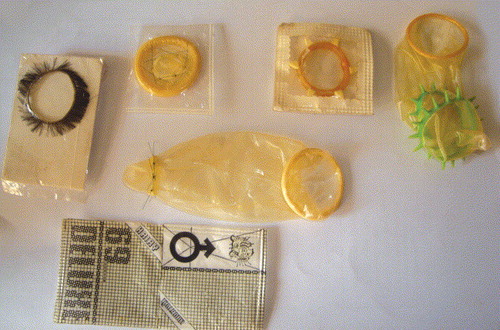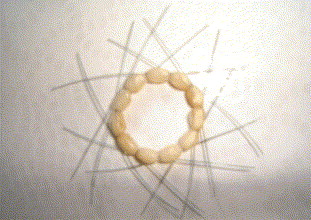Abstract
Condoms remain the sole effective method of prevention of HIV. However, in some places – including Cambodia and China – condoms have been modified to add so-called pearls, hard rubber studs or even bristles that are painful and dangerous to the receptive partner, causing injury to the vagina and anus. Such injuries contribute to the transmission of disease, so these condoms are not useful for prevention of STIs or HIV. In addition to unsafe condoms, accessories such as the “tiger’s moustache” penis ring have bristles and are as dangerous in the same way as unsafe condoms. Public health officials have outlawed the sale of unsafe condoms in Thailand, a step that should be taken in all places where both they and other unsafe accessories are available.
Résumé
Les préservatifs demeurent la seule méthode efficace de prévention du VIH. Néanmoins, dans certains pays, notamment au Cambodge et en Chine, on a ajouté aux préservatifs des « perles », des clous en caoutchouc ou même des crins qui sont douloureux et dangereux pour le partenaire, blessant le vagin et l’anus. Ces lésions contribuent à la transmission de la maladie et ces préservatifs ne sont donc pas utiles pour prévenir les IST ou le VIH. Outre les préservatifs non protecteurs, des accessoires tels que les anneaux pour pénis « moustache de tigre » sont munis de crins et présentent les mêmes dangers que les préservatifs modifiés. Les responsables de la santé publique ont interdit la vente de ces préservatifs en Thaïlande, une mesure qui doit être prise partout où ces articles ou d’autres accessoires dangereux sont disponibles.
Resumen
El condón continúa siendo el único método eficaz para la prevención del VIH. Sin embargo, en algunos lugares, como Camboya y China, el condón ha sido modificado para añadir las llamadas perlas, protuberancias duras de látex o cerdas uniformes que son dolorosas y peligrosas para las parejas receptivas, porque causan lesiones a la vagina y al ano. Tales lesiones contribuyen a la transmisión de enfermedades; por tanto, estos condones no son útiles para la prevención de ITS o VIH. Además de los condones inseguros, los accesorios como el anillo para pene “bigotes de tigre” tienen cerdas y son igual de peligrosos que los condones inseguros. Los funcionarios de salud pública han prohibido la venta de condones inseguros en Tailandia, una medida que debería tomarse en todo lugar donde se puedan adquirir tanto éstos como otros accesorios inseguros.
Condoms remain the sole effective method of prevention of HIV and should be promoted as such. Variety in condom size, colour, flavour, lubricant and texture is all wonderful, but condoms are not problem-free. There are not only negative perceptions of condoms and stigmatisation of condoms, but also something that is often overlooked, which is that some condoms have been deliberately modified to make them unsafe ().
Choun Neth, a Cambodian sex worker and member of the secretariat of the Women’s Network for Unity, the Cambodian sex workers union, discovered that there are also sadistic condoms that are used to hurt sex workers. One type has hair all around it and is called a “tiger’s moustache” (, centre). “It is used, not to make the girl happy but to make the man happy. The one with the most bristles makes me kick them away.”
Other unsafe modifications include the addition of small beads, sometimes called pearls, to condoms, or hard rubber studs that protrude by half a centimeter (, top right). In addition to unsafe condoms, there are also unsafe accessories such as the “tiger’s moustache” penis ring (, top left, and ) which have similar bristles and are as dangerous as the modified condoms.
These condoms and accessories cause injury to the vagina and anus. These injuries contribute to the transmission of disease, so these condoms are not useful for prevention of STIs or HIV. These are condoms that promote rather than prevent HIV. These condoms and accessories are found in Cambodia and China and possibly elsewhere. Public health officials have outlawed the sale of unsafe condoms in Thailand, a step that should be taken by all nations in which these unsafe condoms and accessories are available.
Implications for HIV prevention efforts and research
Many people around the world who work to promote safe sex and prevent HIV are unfamiliar with these unsafe condoms and accessories. There are implications for research and HIV prevention efforts in places where unsafe condoms are available. A methodologically impeccable study of violence against sex workers Citation1Citation2, in Phnom Penh found that 97% of the more than 1,000 sex workers interviewed reported having been raped in the previous 12 months. Some sex workers reported the use of unsafe condoms like “tiger’s moustache” condoms for rape. Sex workers described unsafe condoms as a form of violence, rather than a form of HIV prevention. Sex workers reported that the use of these condoms led to bleeding as well. Citation2
Additionally, even textured condoms that are safe may not be appropriate for all populations. People who have sex numerous times each day may experience irritation from textured condoms. Dr Zhang Ning described learning this when she started working with sex workers in Qingdao, China. She initially distributed ribbed condoms to sex workers, and was told to go away. “I went back and asked them why, and they said they didn’t like condoms with a ribbed texture. They asked me if I had lubricant… Later, I had a better understanding after chatting with some of the sex workers. The reason they don’t like the texture is quite simple… they have to serve so many clients everyday, and frequently washing the vulva makes it very dry. As a result, the ‘sensation’ condoms with their textured surface could cause injury to the vagina.” (Citation3)
Condom use and rape
There is no such thing as safe or acceptable rape. It is imperative to ensure that “rape with a condom” is not seen as an acceptable alternative to stopping rape. However, knowledge of whether condoms were used in rape offers an evaluation of risk of HIV transmission for the victim. One Cambodian sex worker interviewed in February 2006 said “I have faced violence, including gang rape, in February 2006 in Kampot. One client asked me to have sex and we went far away to a field and 19 people were waiting there. Only nine raped me. But fortunately they all used condoms.”
Further considerations
It is equally important that hysteria and panic about unsafe condoms, like those pictured here, not be used to prevent or undermine safe condom promotion and that greater awareness of unsafe condoms does not lead to unintended promotion of unsafe condoms.
Safe sex promotion requires healthy condoms for HIV prevention. This excludes any kind of unsafe condoms. Manufacture and sale of condoms with bristles should be banned. Some healthy condoms are not appropriate for people who have sex extremely frequently. Condom users, including those who enjoy frequent intercourse, are the best people to decide what types of condoms work for them, and the full range of healthy condoms should be made available to all.
References
- C Jenkins. Cambodian sex workers conduct their own research. Research for Sex Work. 8: 2005; 3–5. At: <www.researchforsexwork.org>.
- C Jenkins. Violence and Exposure to HIV among Sex Workers in Phnom Penh, Cambodia. 2006; POLICY Project: Washington, DC. At: <www.researchforsexwork.org>.
- Zhang N. What do I see in the health clinic? Presentation at “Out in the Sun – Legal Constraints and Possibilities in Protecting the Rights of Sex Workers: An International Conference on the Sex Industry and Workers’ Rights”. City University of Hong Kong, 2 May 2004.

